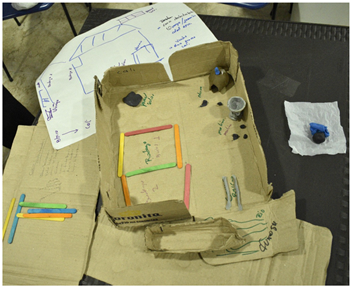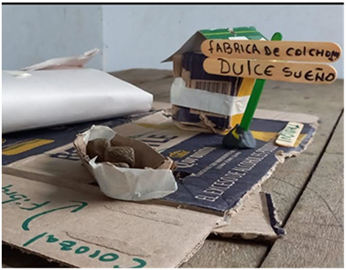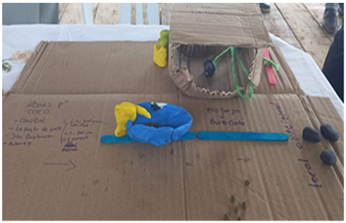Abstract
Most countries in Latin America and the Caribbean rely on agricultural products without value-added processes, resulting in limited profit margins and reduced economic and social development. This research was conducted as part of the “Strengthening of the Coconut Production Chain in the Cauca Pacific Coast—Copacífico” project. The primary aim of this endeavor was to develop and validate a methodology for the systematic prioritization of solutions aimed at enhancing the value proposition of coconut fiber (tow) within the communities situated along the Pacific coast of Cauca, Colombia. The methodology is based on a set of interconnected concepts: the innovation funnel, human-centered design, and social innovation, complemented by lean startup, scrum, design sprint, and the inventive problem-solving theory TRIZ. These concepts are integrated with the blue ocean strategy, value proposition, and CANVAS. The validation process focused on prioritizing value-added alternatives for coconut fiber by-products (such as coir), resulting in desirable, feasible, and viable solutions achieved through a robust and participatory methodology. Consequently, this methodology is deemed suitable for innovation processes in rural regions, requiring the collaboration of universities, companies, and governmental entities to formulate solutions aligned with the challenges and specific contexts of their territories, while focusing on sustainable development.
1. Introduction
In Latin America, agriculture constitutes approximately 5% of the gross domestic product (GDP) across 20 regional countries. Although the majority of exports directly contribute to the sustenance of numerous individuals and play an important role in keeping international prices stable and under control, these exports primarily comprise raw materials. These raw materials, stemming from unprocessed agricultural products, possess limited added value [1]. Such a situation reduces the possibility of participation in dynamic markets and, consequently, of profitability and opportunities for economic and social development for communities. Therefore, the necessity to formulate novel sustainable production models rooted in the evolution and value augmentation of agriculture and the food sector is evident [2].
For the year 2017 in Latin America, the incidence of poverty and extreme poverty was highest among residents of rural areas, children and adolescents, women, and indigenous people and the Afro-descendant population, among other groups, and its incidence reached rates higher than 40%, being up to three times higher than in urban areas [3]. Moreover, more than two-thirds of the rural population of developing countries exhibit high rates of poverty. The United Nations (UN) establishes the “end of poverty” as a sustainable development goal aimed at sustained economic growth, the reduction in labor informality, the promotion of decent work, and comprehensive social protection systems.
Likewise, the objective called “Zero Hunger” proposes doubling agricultural productivity and the income of small-scale food producers, particularly for family farming models, through markets and opportunities for the generation of added value and non-agricultural jobs [4]. In Colombia, the main objective of the Strategic Plan for Science, Technology and Innovation of the agricultural sector [5] (PECTIA, 2017–2027) is to guide the sector’s policy on said topics to increase competitiveness, sustainability, and improvement of the living conditions of the population in accordance with the conditions and potential of the country. In this document, the thematic area of harvest, post-harvest, and transformation management urges the development of value-added technologies for the diversification of the product offer and the integral use of by-products that potentiate the sectoral agricultural industry [5]. And it is under this perspective that the proposal for value generation in the coconut produced on the Colombian Pacific Coast is generated.
Current research indicates that the worldwide coconut market has meanwhile enjoyed a gradual increase in the last decade, motivated mainly by the use of products and by-products in the food, beverages, and cosmetics industries—sectors that have invested in research and development to improve the characteristics and properties [6]. World coconut production was 62,875,216 metric tonnes in 2019 with an increase of 8,8% over the last three years. The countries with the highest production and growth during the last three years were India with 31.5%, Sri Lanka with 26%, and mainland China with 22.7%. Colombia ranks 24th with a participation of 0.23% and an increase of 32% during the years from 2010 to 2019 [7].
In this nation, the department of Cauca was the second-largest producer nationwide with a contribution of 19% (28,232 tons) [8]. Coconut production in Cauca, mainly of the Typical and Manila varieties, took root in its coastal zone from the 1960s on, mainly in the municipalities of Timbiquí, Guapi, and López de Micay. Currently, it is estimated that in the three municipalities there are 1200 producers in the context of a family economy, with 4500 hectares planted in a disadvantaged territory, with high levels of poverty and severe restrictions for transformation. In this area of the country, the coconut is harvested on the farms and sold, without undergoing any kind of transformation, to local collection centers. In these centers, the mesocarp is removed, and later the shelled coconut is sent by river and sea to a main port, the place from which it is marketed and transported by land to the interior of the country. The product is agro-industrially transformed in developed cities, and later incorporated into a wide variety of food and non-food products. A very small part of the coconut that is produced on the Pacific Coast of Cauca is transformed locally into handicrafts and traditional products of the territory such as sweets, baked goods, and oils, which exhibit a very low articulation with the market [9].
In order for the coconut-growing community in Colombia to meet a market demand with innovative products that can compete with international supply, it is necessary to innovate in rural agri-food systems through learning, knowledge, and local experience that will lead to improving productivity and product competitiveness, and the articulation of producers, consumers, intermediaries, government institutions, and private companies in new organizational forms [10]. However, innovation theories and concepts for rural development need to be adjusted to commercial and social contexts. For this, state support is required for agricultural activities and the population living in poverty, alongside citizen participation and a new public–private relationship with an approach sensitive to gender and ethnic identity [11].
Nonetheless, any innovation process with a view to adding value requires focusing solutions within a wide number of possibilities on which the efforts for research, development, and technology transfer will be concentrated. Ref. [12] indicate that, on average, around 3000 raw ideas are generated and almost all of these ideas are rejected in the new product development process to obtain a commercially successful product. In a highly competitive environment, knowing how to prioritize is essential for organizations and much more so for social and productive development projects.
For its part, having a structured and business-focused prioritization process is essential for the successful implementation of an integrated innovation framework in any business. In light of this, there are a series of factors that define aspects that must be taken into account: (1) Value for the organization; (2) Adaptation to the vision of the business and the environment; (3) Viability; (4) Market acceptance; (5) Durability [13].
The Economic Commission for Latin America and the Caribbean [14] proposes the bioeconomy as a techno-productive paradigm for regional agricultural development and activities based on biological resources. Colombia, in recent years, has accorded notable attention to its progression. The “Mission of Wise Men 2019,” convened by the National Government to contribute to the formulation and enactment of public policy in education, science, technology, and innovation, underscores that the bioeconomy is not delineated as an autonomous sector but rather as an interconnected assembly encompassing diverse value chains. This interrelation extends across numerous existing sectors, including agriculture, the food domain, forestry, the timber industry, waste management, industrial bioproducts, and energy [15].
Furthermore, the project titled “Strengthening of the Coconut Production Chain in the Cauca Pacific Coast—Copacífico” aims to explore alternative avenues for deriving value from coconut fibers. However, the implementation of sustainable productive initiatives in rural communities is compounded by intricate factors encompassing social dynamics, cultural considerations, and the provisioning of fundamental services and infrastructure. As such, many endeavors within the intervened community, even with government support, have failed. Notably, the literature review did not reveal a methodology capable of effectively prioritizing a condensed array of value-adding solutions for agricultural product development. As a result, this study was directed towards formulating and verifying a methodology pertinent to the coconut industry, with potential applicability to diverse innovation processes within rural settings.
This methodology is supported by the concept of the innovation funnel and tools of social innovation, design thinking, human-centered design and lean startup, sprint design, and scrum. At the same time, the theoretical concepts of the blue ocean strategy, value proposition and CANVAS are integrated. The results presented are derived from the research project, “Strengthening of the coconut production chain of the Cauca Pacific Coast”, formulated by the University of Cauca and financed by the General System of Royalties through the Technology and Innovation Fund (SGR-Tel) that is channeled through the Government of Cauca.
1.1. Theoretical Foundation
1.1.1. Added Value, Technological Innovation, and Social Innovation
Added value is developed through strategies that allow the assessment of the attributes of a product and/or process. In other words, it focuses on the physical transformation of a product for a second or third period of life, as well as the differentiation of each product according to the changes to which it has been subjected and the increase in efficiency in the use of available resources for the generation of different products or their reuse. On the other hand, value generation is related to innovation processes and the ability to increase the profitability of transformed or improved products. Consumers, for their part, are an important link in the chain of adding value, since the price depends on the recognition of the quality–functionality relationship of the products [16].
In this sense, Ref. [17] takes the definition of technological innovation proposed by the OECD 1993 ([18], p.11), indicating that it is “the first application of science and technology in a new direction, followed by commercial success”—that is to say, it is the transformation of an idea into products for the satisfaction of needs or services that improve the quality of life of a social group and thus remain in the market. Ref. [19] similarly affirms that technological advances support social welfare and contribute to economic growth, since the transformation of goods and services is carried out under the criteria of efficiency, novelty, and quick solutions to the fluctuating needs of society and the market itself.
From what has been stated, the concept of the innovation funnel arises, which is the process of purifying ideas for their optimal management and development, that is, the managed ideas allow the creation of new products, be they by way of services or technologies that can be implemented and marketed. This consists of four phases or stages: idea generation, idea selection for development, testing and evaluation, and value creation [20]. In this sense, Ref. [21] mention that the innovation funnel is closely linked to the development of new products in the field of open innovation due to the fact that it allows the introduction of concepts such as open business models and open service innovation.
To this extent, innovation in rural areas is closely related to social innovation, defined as new ideas (products, services, and models) that simultaneously satisfy social needs (more effectively than alternatives) and create new social and collaborative relationships, fostering social capacities for action [22]. Thus, for [23], innovation is defined as the creation of new products or the improvement of these, as well as the development of innovative processes that guide their life periods to the solution of individual or collective needs, such that they allow the transformation of the social environments where they are used.
Despite having definitions of innovation and added value, where the main purpose of the products—be they processes/services or equipment—is meeting the needs or embracing new paths of human relations through technology, the way in which rural areas can also come to generate solutions to their own needs at a local scale is not visible. Thus, the business context can be addressed with tools such as design thinking, which focuses on solving problems from the end user’s perspective; thus, design creativity is based on the ability to deeply understand needs from particular contexts [24]. Ref. [25] describes five steps that are relevant in the social innovative process: listen to the community, identify opportunities, find solutions, provide tools, and execute solutions.
In relation to design thinking, this is an interactive and cyclical process, where the interactivity between criteria and creativity are combined to work in these five stages: empathize, define, devise, prototype, and evaluate. Therefore, criticism allows the use of theories and concepts in a pragmatic and succinct way, so that creativity has the possibility of making directed and feasible decisions [26]. In this sense, Ref. [27] propose human-centered design as a method of problem solving based on collaborative innovation management. This definition is not far from what was stated by [28], which indicates that it is a “systematic process dedicated to solving problems focusing on the approach of opinions and possibilities”, where the groups or people are the fundamental actors in the creation of ideas and in proposing solutions that end up being pertinent, as well as being consistent with realities and needs.
Human-centered design thus develops in the three phases of hear, create, and deliver. Hearing allows the collection of inspirational elements; creating allows prototypes of selected solutions; and in delivering, the solutions are taken to financial and cost models in order to analyze the implementation requirements and useful life of the proposals raised by the participating groups. As such, this design suggests that the groups are made up of characteristics of equity and social inclusion (Figure 1).
1.1.2. Methodologies and Tools for Innovation
In the hybrid methodology proposed for this research, there is a convergence of elements of design sprint, which is used in the experience of designing and creating any good or service. This allows the intended recipients of the service to be taken into account before its production and thus results in a shortening of the design/construction processes/times, which reduces costs. Finally, a viable product is achieved, and the errors when it becomes available on the market will be fewer [29]. This methodology is developed under the phases of understanding the problem, working individually on the solution, deciding which solution to develop, prototyping the solution, and validating the solution [30].
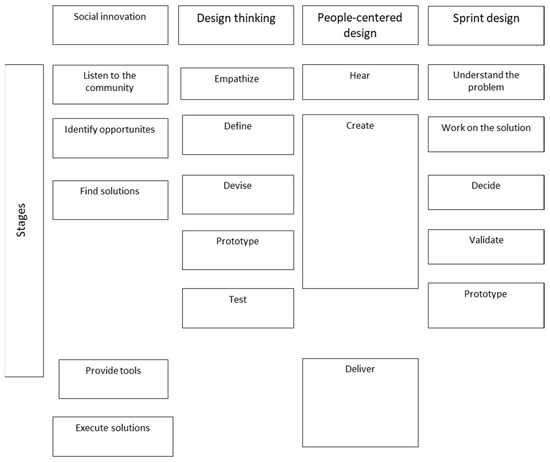
Figure 1.
Comparison of the stages of social innovation, design thinking, and human-centered design. Source: Own compilation based on [25,26,28,30].
The proposed methodology is reinforced by lean startup, which is aimed at implementing innovative ideas for the creation of a startup. Firstly, it focuses on a three-step circuit: creating a product, measuring results, and learning from mistakes; thus, building a product can be measured through data and ideas can be adjusted to make the product viable, achieving validated learning. Secondly, it works under the uncertainty principle, which allows learning in a short time and with minimal investment; it is aimed at reducing the chances of failure [31,32]
Despite having these methodologies as pillars for community work and understanding the community’s needs, it is necessary to apply another one that allows the resolution of technical problems that arise during the creation process, for which the inventive problem-solving theory (TRIZ) method was used in this work. This consists in the solution of inventive problems and starts from a problem to which a battery of 39 technical parameters and a contradiction are applied. This allows us to show that the difficulties raised have been handled using scientific knowledge [33]. The combination of TRIZ and design thinking approaches facilitates the generation of alternative solutions through the separation principles or the contradiction matrix, since TRIZ does not consider the user for whom it is being designed, a fundamental aspect in design thinking [34].
Due to the above, the business design method called scrum was also applied. This method is used in companies and in this case it was carried out at local scale or in areas that presented the following characteristics: uncertainty, self-organization, moderate control, and transmission of knowledge. It is characterized by presenting interactions between characteristics, calling each of them “Sprint” [35]. Likewise, this methodology facilitates the incorporation of the client in the process, flexible planning, teamwork, acceptance of failure, and the diffuse profile of the target in its early stages [36].
The bases of the blue ocean strategy consider projects that have particular characteristics (i.e., remote locations), in which high product costs are implied due to the transportation and marketing. The blue ocean strategy is defined as a new way of thinking and it is based on innovation in value. It also leaves aside the competition and focuses on the creation of new products that take into account the main needs of a particular group of people and is used in the first stage of ventures to identify the product and market [37,38].
The concatenation of these methodologies and/or tools includes a value proposition that makes it possible to identify what customers want and expect, and they are also adjusted as user needs change. The value proposition acquires its relevance as soon as the logical sequence with which it acts is understood, which is why the method includes an analysis of customers in order to understand their requirements. The value map allows the creation of value within the product, so that it is attractive, and a fit that is at the intersection between the customer profile and the value of the product [39]. Finally, the methodology conceptualized here allows the community to imagine a business model with a common language, where its design and application is carried out in a fast, agile, simple, and understandable way so that the proposed strategies have a business structure and respond to the requirements of the participating social groups or communities.
2. Materials and Methods
This methodological proposal arose within the framework of the research project “Strengthening the productive chain of coconut on the Cauca Pacific Coast (COpacifiCO)” financed by the National Royalties System of Colombia and executed by the Universidad del Cauca in the territory. The main objective was to identify strategies to add value in the territorial area where coconut is produced (Pacific Coast of Cauca), and through them explore alternatives that allow producers to improve their income and communities to improve their social and economic development, since this territory has the highest rates of poverty and violence in the country.
The COpacificO project was carried out between 2021 and 2023 on the Pacific coast of Cauca in Colombia, specifically in the municipalities of Timbiquí, Guapi, and López de Micay, located on the southwestern coast of Colombia, a region with natural and water wealth, surrounded by the Pacific Ocean. It is an area with high levels of poverty and incipient access to public services. Its only transportation options are air and river (through the Guapi, Timbiquí, Saija, and Micay rivers).
The COpacifiCO project consisted of two stages. In the first, a characterization of the links that make up the coconut value chain was carried out with the purpose of having an updated diagnosis that allows the recognition of its operation. For this, instruments were designed (surveys, interviews, panels, visits to the production systems) to identify the number of producers and their characteristics, and the particularities of the farms where the fruit is produced. In this initial stage of the project, the other links that are articulated in this chain were analyzed, including the links between agro-industrial transformation and the marketing of fresh coconut and its derivatives in the most developed areas of the country. At the same time, environmental analysis studies, commercial and technological surveillance, and prospective studies were carried out to recognize the realities and trends in coconut consumption in Colombia and the world. Based on the above information, the second stage of the project was structured, in which prototypes were developed at the laboratory level with the purposes of identifying the technical and financial possibilities for obtaining them on the Pacific coast and achieving a successful commercial articulation.
Between the first and second stages of the project, it was necessary to prioritize value-added alternatives for coconut in order to identify a reduced set of value-added solutions from a wide variety of valorization alternatives for this fruit. The validation of this methodological proposal was carried out with the community of coconut producers on the Pacific coast of Cauca in Colombia and was limited to the prioritization of value-added alternatives for coconut fiber by-products (tow).
This methodological proposal for the prioritization of value-added alternatives was carried out under a qualitative and quantitative approach, considering a wide range of tools to apply within the concept of the innovation funnel (Figure 2). Because it is a social process, it was supported in the development of co-participatory methodologies. Below is the scheme of the adjusted hybrid methodology that resulted from the validation carried out and that is proposed as a methodology to be replicated in other processes of prioritization of value-added alternatives for agricultural products.
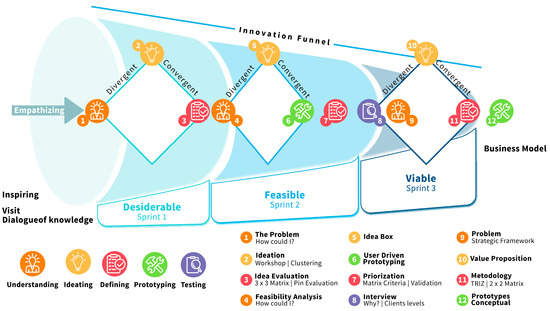
Figure 2.
Proposal of the hybrid methodology. Source: Own compilation.
Figure 2 depicts the innovation funnel, portraying an initial influx of numerous ideas that undergo a process of systematic prioritization before reaching a reduced number of solutions, for which models are specified that allow the consolidation of these initiatives in the territory.
The general prioritization methodology is made up of three sprints and each of them is represented by a diamond. The three diamonds are integrated with each other through a systemic model that allows gradual progress in the process of prioritizing value-added alternatives, going from a large number of desirable products to a smaller group of feasible ones and, finally, from the group of feasible products to the final group of feasible products. This is achieved by using a divergent or convergent thinking approach that flexes and contracts the alternatives throughout the process until reaching the final selection. Within each diamond, twelve moments are contemplated in which the participating actors are expected to advance through a process of understanding, devising, defining, prototyping, and testing.
The methodology began with the establishment of relationships between the community responsible for agricultural production and the team of facilitators of the prioritization process. For this, the linking of personnel from the territory within the work team was decisive in facilitating the entry relations with the community and later opening the door to a gradual process of building trust between the actors, which allowed the activities to evolve effectively in order to develop such aspects as characterization, interviews, immersions, environmental surveillance, technological surveillance, and commercial surveillance, among others.
2.1. Roles Defined in the Methodology
Once the link with the community was established and the participating actors were selected, teams were formed and roles were assigned according to the objective of each moment. It thus featured a design team, a technical team, a guiding team, clients, stakeholders, and a facilitator. Table 1 shows the formation of the teams and suggested roles for the application of this methodology.

Table 1.
Formation and functions for the roles defined in the methodology. Source: own compilation.
2.2. Sprint 1. In Search of Desirable Solutions
The first sprint had as its objective that the proposed solutions of added value for agricultural products are desirable. For this, the construction of a map of problems was started, which evolved to the production of ideas and culminated with an evaluation of these alternatives according to the value for the market and the level of complexity that their implementation has in relation to the available technologies. Internally, moments of both convergent and divergent thinking were used, going through the methods of understanding to devising and culminating at the stage of defining. It contained three moments which are detailed below (Table 2):

Table 2.
Moments of the first sprint. Source: own compilation.
2.3. Sprint 2. In Search of Feasible Products
The second sprint, aimed at making the solutions feasible, began with a feasibility analysis of the ideas identified as having potential in the first sprint and led the community and technical team to carry out a prototype of the solutions, as well as evaluate them and imagine their implementation and operation in the territory. This stage culminates with the quantitative application of a factor evaluation matrix. It has two moments of divergent thinking and goes through the moments of understanding, devising, prototyping, and defining in the four moments detailed as shown in Table 3:

Table 3.
Moments of the second sprint. Source: own compilation.
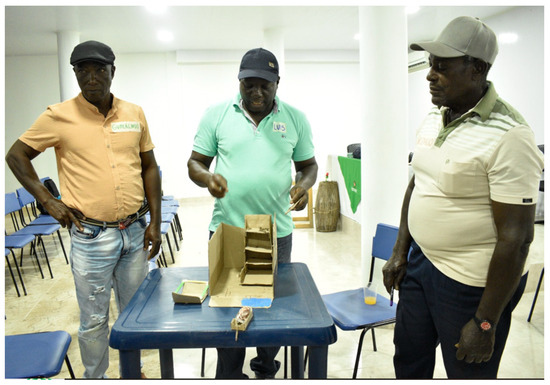
Figure 3.
Prototyping Workshop. Taken by Ana Maria Sicard (2022) (Anthropologist, COpacifico Project).
To determine the criteria for the prioritization matrix, the results of moment 1 of the problem tree were used, to the extent that it allowed the workshop participants to obtain clear elements for their identification and objectively weigh their qualifications.
2.4. Sprint 3. In Search of Viable Solutions
The third sprint began with the pre-validation of the solutions so far prioritized through the application of interviews with potential clients of the solutions. In the instrument, competitors and substitute products were evaluated. A first value proposition idea was built, evaluating innovative aspects that could be incorporated into the idea and evolving in the approach of a possible business model for the implementation of the solution. This diamond has two moments of convergent thinking, two of divergent thinking, and finally the TRIZ methodology that applies both modes of thought at the same time. It begins with the test mode, followed by a moment of understanding, devising-defining, and ending with the step of prototyping the business model, each of which is detailed below (Table 4):

Table 4.
Moments of the third sprint. Source: Own compilation.
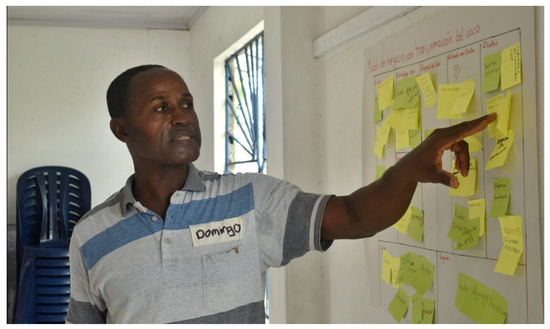
Figure 4.
Prototyping workshop business model. Taken by Ana María Sicard (2022) (Anthropologist, COpacifico Project).
The Blue Ocean Strategy’s value curve tool was suitably adapted for moment 9, corresponding to the relevant strategic framework, constituting a visual representation of the comparative performance of the prioritized product in relation to the variables associated with its nearest competitor or substitute. As articulated by [37], the horizontal axis encompasses the spectrum of industry-relevant variables subject to investment and competitive dynamics, whereas the vertical axis quantifies the level of value offered to buyers concerning the identified variables ([37], pp. 37–38). In this context, the variables were identified and ranked by the workshop team on a scale from 1 to 5, where 5 denotes a product providing exceptionally high value, 4 represents high value, 3 signifies medium value, 2 implies low value, and 1 indicates very low value. The resultant graph showcases an averaged representation of the workshop-assigned ratings.
3. Results
The hybrid methodology made it possible to achieve the objective set around prioritizing four products that, in the execution of the project, went to the research stage, providing peace of mind to the technical team, because they were defined through a legitimate process with the participation of both the community and the stakeholders. The community and the technical team qualified this methodology as participatory, robust, and applicable to other prioritization methods used in processes of adding value to agricultural products. Additionally, the methodology made it possible to obtain valuable and useful information when implementing the solutions for the transformation and addition of value in the territory. Furthermore, while the process of research and development of the functional prototypes was advancing, the methodology allowed the community to visualize some clear tasks for the appropriation of the technologies and business models that needed to be implemented to put the solutions on the market. The most relevant results of the validation of the methodology are presented below.
Moment 1 was called Understanding the problem. After building the problem map that started from the question “Why is there low use of coconut fiber on the Pacific coast of Cauca?” the participants grouped the contributions into economic, commercial, social, production, and environmental aspects and the answers were specified in the following table (Table 5) where the findings were identified, and the respective guiding question was constructed for each one.

Table 5.
Guiding questions, resulting from the Understanding the problem workshop. Source: Own compilation.
The methodology fails to resolve all of the guiding questions identified in the problem tree, but it will be necessary to consider some of them in the feasibility and/or viability stages. The design team therefore decided to focus on the question: “How could the coconut-producing community on the Pacific coast of Cauca have a transformation activity that motivates the community and lasts over time?” In this regard, the ideas of the participants were obtained and grouped into seven areas of opportunity, as follows (Table 6):

Table 6.
Solutions generated for guiding question. Source: Own compilation based on ideas from the technical team and community design team.
In relation to the question, “What products could be transformed on the Pacific coast of Cauca from the fiber and that could have a constant demand in the market?” the 76 solutions identified were later grouped into 13 opportunity sub-areas and these, in turn, into 4 opportunity areas: construction, home and decoration, industrial applications, and textiles and fashion. The opportunity sub-areas with an idea of the solutions were evaluated in the 3 × 3 matrix presented below (Figure 5):
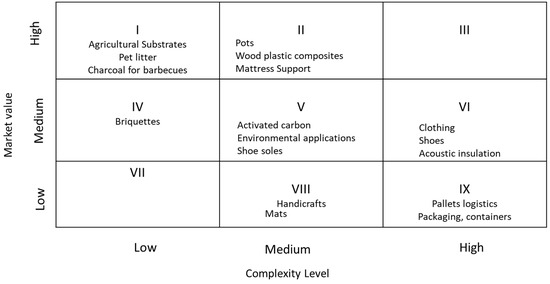
Figure 5.
Sub-areas of opportunity 3 × 3 matrix. Source: Own compilation based on ideas from the technical team and community design team.
The application of the PIN evaluation, the subsequent moment of feasibility analysis, and the Box of Ideas workshop allowed us to identify the possible problems in the implementation of the solutions identified so far by the participants as having the greatest potential. Using a traffic light (Table 7), those implementation problems that might have a feasible solution were identified in green; those that should be analyzed further in yellow; and those for which participants definitely could not find a solution, in red. The solutions in green go on to the next stages of the methodology.

Table 7.
Feasibility analysis of prioritized solutions. Source: Own compilation based on ideas from the technical team and community design team.
The methodology allowed the construction of the criteria prioritization matrix in which eight criteria identified by the participants and applied to the products that passed to this stage were evaluated. The matrix is presented in the Table 8.

Table 8.
Criteria prioritization matrix. Source: Own compilation based on ideas from the technical team and community design team.
The results of the prototyping workshops carried out with the community and technical team are presented below, in which the possible operation of the value-adding process in the territory of the solution is visualized and allows the identification of the limitations and critical factors of its implementation (Table 9):

Table 9.
Prototypes of the operation of the prioritized solutions. Source: Own compilation based on ideas from the technical team and community design team.
As an example, the strategic framework is presented in which the workshop participants identify the competition and/or substitute products for one of the prioritized products up to the moment, which corresponds to plastic wood (Figure 6). For this, both the wood available in the area from the trees of the territory and the plastic products acquired in the interior of the country were identified as substitute products. In the strategic framework, the characteristics valued by the clients were identified, such as durability, resistance, light weight, resistance to humidity, resistance to fire, and being environmentally sustainable. In the qualification of the workshop participants, plastic wood has advantages over the two substitute products in its light weight, in its price, and in its favorability for the environment.
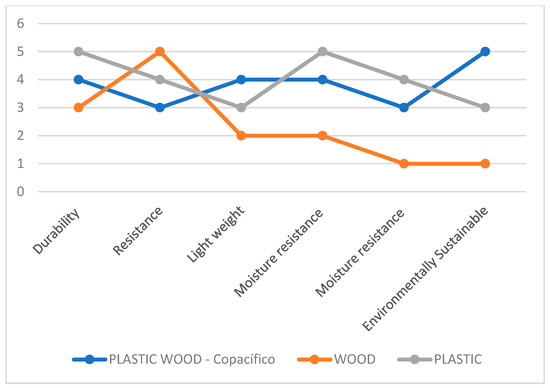
Figure 6.
Strategic framework for agricultural substrates. Source: Own compilation based on information provided by the workshop.
Below, as an example, the fit-value proposition for plastic wood is presented (Figure 7), in which the needs are defended so that the technical team could consider its development, such as the need to offer it in different sizes, the standardization, and the resistance to humidity, among others.

Figure 7.
Value proposition for the plastic wood product. Source: Adaptation from [40].
Figure 8 presents the business model with transformation that was visualized by the community for the addition of coconut value on the Pacific coast of Cauca for the prioritized products.
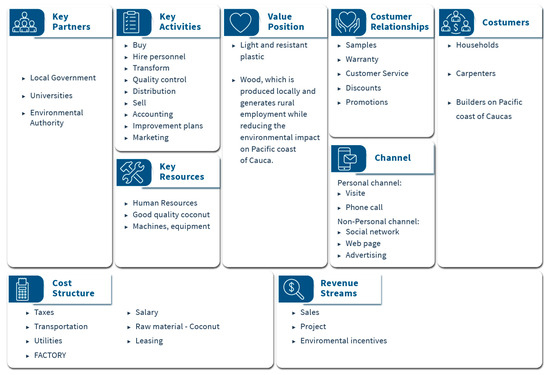
Figure 8.
Business model prototype for plastic wood. Source: Adaptation from [39].
Likewise, the capacities identified by the workshop participants are presented (Table 10), clustered according to the capacities they already have and those they do not have, identifying a possible partner or ally.

Table 10.
Identification of capacities. Source: Own compilation based on ideas from the technical team and community design team.
4. Discussion
To effectively address innovation in rural regions of Latin American countries, it becomes necessary to investigate methodologies adapted to their specific contexts and challenges. The presented approach aligns with the framework proposed by [41], emphasizing the recognition of innovation processes beyond the technological and economic facets aimed at the market. It also encompasses the social and institutional dimensions, which include the integration of novel solutions to address intricate societal issues within the framework of a theory of social change.
Ref. [42] highlights the necessity for societal stakeholders to formulate propositions grounded in an appreciation of the intrinsic value of the natural environment and its multifaceted contributions: encompassing supply, regulation, support, and cultural services. In alignment with this perspective, the employed methodology enabled participants to conceptualize business ventures and discern and rank solutions rooted in the utilization of by-products derived from a comprehension of coconut cultivation as an agroecosystem. Furthermore, it facilitated the anticipation of challenges that might emerge during implementation, including constraints associated with infrastructure, public services, and elevated transportation expenses, among other obstacles—predicaments commonly encountered within rural areas across Latin American nations.
In this regard, a methodology directed towards the prioritization of value-enhancing solutions, grounded in the principles of innovation and inclusive of diverse stakeholders deeply connected to their territories, will undoubtedly be oriented to alternatives aligned with sustainable development. Through the validation of this methodology, as exemplified by the ranked solutions, the involved actors demonstrated a pronounced consideration for both environmental and social dimensions within their decision-making processes. In line with this notion, [43,44,45] highlight a paradigm shift observed in productive entities. These entities, formerly viewed as intensive and extensive production units driven by profit maximization, have progressively evolved into agroecosystems. This transformation signifies a harmonious integration of production practices with soil preservation and biodiversity conservation, thus embodying a sustainable coexistence.
The [7] states that coconut is produced in approximately 93 countries and that it covers a land area of approximately 12.3 million hectares. Mexico is among the best represented. Colombia, however, fails to show as a coconut-producing and coconut-exporting country. The new understanding of coconut crops as an agroecosystem has allowed the identification and prioritization of solutions based on the use of its by-products in the form of activated carbon and agricultural substrates, plastic wood, and mattresses (the last two identified by the community for self-consumption).
The transformation of agricultural substrates from coconut residues is consistent with the proposal made by [46] who state that the management of coconut residues, in addition to generating environmental benefits focused on the mitigation and control of contamination by the transformation of coconut, also generates benefits in the fertilization of crops or gardening and that these residues can be used as fertilizers due to their high concentration of nutrients. The authors agree with the social actors participating in this research, who see the opportunity to take advantage of and recycle organic waste, which translates into the recovery of bio-waste and thus strengthens the circular economy enclaves.
For [47], plastic wood, despite requiring a mixed composition (vegetable residues and reusable plastic residues), has become a notable product since it possesses reliable characteristics such as resistance, malleability, maintenance, and hardness. In addition, its manufacture can reduce environmental pollution and manufacturing costs. Similarly, Ref. [48] affirm that the production of mattresses from coconut fiber is possible. The authors indicate that the use of the fiber has a natural anti-allergenic property, which is why its production becomes a healthy and environmentally friendly option since it allows its recycling and introduction to circular-economy processes, generating benefits for the coconut agro-production collectives linked to this undertaking. The authors’ work supports this solution since it presents a community experience, where coconut fiber was obtained for the manufacture of hypoallergenic ecological mattresses, stating that these mattresses degrade faster because they are a vegetable fiber compared with those made with synthetic fiber, derived from petroleum.
Within the community perspectives, the authors indicate that the actors participating in the process directly benefited economically from the coconut crops and that they also generated sources of work and extra income with manufacturing and marketing. Already, in the case of the coconut collective of Cauca Pacific, this initiative was valued by the community with the orientation towards self-consumption. Since transporting mattresses to their localities is expensive, local production for on-site consumption is a priority.
The solutions proposed and supported are intertwined, as mentioned, with the circular economy. By spontaneously participating, the social actors allowed the hybrid methodology applied here to be validated and adjusted, to such an extent that the projections towards new paths have allowed paths towards economically and environmentally more just and sustainable societies to be undertaken [49]. For this reason, the methodologies engaged herein have allowed social actors to propose solutions that combine the use of nature under social responsibility, where the beneficiaries see in nature the opportunity to undertake and, at the same time, to care for agroecosystems that are their main source of income, as well as understanding that science is not only the application of complex methods, but on the contrary they make up the most significant group for the success of the processes and that ultimately the continuity of the actions proposed as an alternative for better socio-environmental living [50,51].
Consequently, the applied methodologies have allowed the social actors involved to appropriate their feelings and share thoughts of innovation, so that the social work aimed at strengthening entrepreneurial capacities around the use of coconut by-products on the Colombian Pacific coast finds a role within food security/sovereignty/autonomy. The proposed solutions have had the possibility of generating intersectoral and interinstitutional relations with a view to improving the processes from within and with the communities involved. This does not leave aside the difficulties of the territory, but uncovers and reveals the opportunities for change and improvement of the quality of life of the eco-farmers of the Colombian Pacific, that is, business development can be understood from the efforts of the communities, where the social actors are called to be the new entrepreneurs [52].
5. Conclusions
The current study has utilized methodological hybridization, integrating a range of concepts and tools such as the innovation funnel, people-centered design, social innovation, lean startup, scrum, design sprint, the theory of inventive problem solving (TRIZ), strategic framework, and CANVAS, among others. Although these tools are conventionally employed within the business sector, their innovative application in this context embraced the rural collective identity, specifically directed towards enhancing the value of an agricultural product. This approach has yielded several benefits, including the simplification of intricate technical notions, enhanced flexibility in application, and the reinforcement of process legitimacy. The validation phase substantiated that this application stimulates active engagement from the project’s social stakeholders. This validation process efficiently examined a variety of solution ideas, culminating in a consensus amongst the stakeholders on the suitability of three options for implementation within their territory, thereby catalyzing the progress of decision-making, research, and development endeavors.
Establishing trust among stakeholders is an important aspect within any social innovation process. To achieve this, integrating preliminary activities such as technical visits and knowledge dialogues is advisable. These engagements not only enable the technical team to grasp the intricacies of the social, political, geographic, environmental, and technological landscapes, but also empower the community to envision new possibilities for territorial development grounded in innovation and value augmentation of their agricultural products.
The methodological validation allowed the social actors to add value to the coconut by-products via the recognition of the national bioeconomy policy, because the products were consistent with the agroecosystemic realities of the territory and the needs of the participants, in addition to the technological possibilities available at the time of research. The participants showed that the use of biological resources requires their knowledge and hence the application of innovative methodologies that allow them to go hand in hand with sustainability.
The social assimilation of knowledge by the community occurred through the selection of solutions, reflecting that the value addition of the by-products is not only focused on dividend generation. Instead, it encompasses a paradigm shift in societal perceptions and an environmental enrichment of the territory, recognizing that actions undertaken today will have repercussions through future generations. The community acknowledged that within the participatory process facilitated by the methodology, factors common in rural settings such as limited educational attainment, occupational diversity, gender, and age occasionally posed barriers for workshop participants to contribute meaningfully from their unique contexts. Throughout the process, proactive engagement of women and respect for their insights were encouraged, with particular emphasis on their pivotal role in driving solution implementation within the territory.
Both the community and the technical team qualified this methodology as participatory, robust, and applicable to other prioritization endeavors in rural settings, where academia, governance, and local communities converge for sustainable development initiatives. Within the scope of the present research, it is recognized that this methodology integrates qualitative tools, potentially leading to interpretational challenges in certain results. Therefore, external validation remains elusive, or should be carried out in subsequent stages following solution implementation in the territory. Furthermore, each phase of the methodology involves collaborative design with community members, though during dissemination and socialization, some stakeholders voiced disagreement due to non-involvement. To address this, improved pre-engagement and representation in the initial stages are recommended to ensure inclusive participation during progress-sharing with the community. Thus, forthcoming research endeavors may offer insights into effective communication strategies tailored to specific territorial contexts.
Author Contributions
All authors contributed equally to the research. All authors have read and agreed to the published version of the manuscript.
Funding
This research was funded by COLOMBIAN GOVERMENT, grant number 2018000100040 [Recursos del Fondo de Ciencia, tecnología e innovación, Sistema General de Regalías (SGR-Tel)] through the office of economic development and competitiveness of the department of Cauca, through the execution of the project "Fortalecimiento de la cadena productiva del coco de la Costa Pacífica del Cauca" [Strengthening of the coconut production chain of the Pacific Coast of Cauca].
Institutional Review Board Statement
Not applicable.
Informed Consent Statement
Not applicable.
Data Availability Statement
No data was generated during the investigation.
Acknowledgments
The authors thank the Sistema General de Regalías of the Colombian government, as well as the members of the Colombian Pacific communities.
Conflicts of Interest
The authors declare no conflict of interest and the funders had no role in the design of the study; in the collection, analyses, or interpretation of data; in the writing of the manuscript; or in the decision to publish the results.
References
- Banco Mundial. Panoramas Alimentarios Futuros. Reimaginando la Agricultura en América Latina y el Caribe. 2021. Available online: https://www.bancomundial.org/es/region/lac/brief/future-foodscapes-re-imagining-agriculture-in-latin-america-and-the-caribbean (accessed on 30 June 2021).
- Rodríguez, A.; Rodrigues, M.; Sotomayor, O.; Wonder, P. Innovación, Agregación de Valor y Diferenciación: Estrategias Para el Sector Agroalimentario de América Latina y el Caribe en un Mundo Complejo. 2030—Alimentación, Agricultura y Desarrollo Rural en América Latina y el Caribe, 13; FAO: Santiago, Chile, 2019. [Google Scholar]
- Comisión Económica para América Latina y el Caribe—CEPAL—2019. Panorama Social de América Latina. Available online: https://repositorio.cepal.org/bitstream/handle/11362/44969/5/S1901133_es.pdf (accessed on 15 September 2020).
- Comisión Económica para América Latina y el Caribe—CEPAL—2021. Objetivos de Desarrollo Sostenible. Available online: https://www.un.org/sustainabledevelopment/es/objetivos-de-desarrollo-sostenible/ (accessed on 24 July 2023).
- Departamento Administrativo de Ciencia, Tecnología e Innovación—Colciencias—Ministerio de Agricultura y Desarrollo Rural y Corporación Agropecuaria de Investigación Agropecuaria—Corpoica. Plan Estratégico de Ciencia, Tecnología e Innovación del Sector Agropecuario Colombiano PECTIA (2017–2027). 2016. Available online: https://minciencias.gov.co/sites/default/files/upload/noticias/pectia-2017-actualizado.pdf (accessed on 4 May 2021).
- Allied Market Research. Coconut Products Market. Global Opportunity. Analysis and Industry Forecast, 2019–2026. 2019. Available online: https://www.alliedmarketresearch.com/coconut-products-market (accessed on 30 June 2019).
- Organización de las Naciones Unidas para la Agricultura y la Alimentación—FAO. Sector del Coco: Análisis de Mercado y Aspectos Socioeconómicos Marco General Sobre el Sector del Coco en Jamaica, Ghana y México. 2020. Available online: https://www.tropicsafe.eu/wp-content/uploads/2022/02/Sector-del-coco-an%C3%A1lisis-del-mercado.pdf (accessed on 10 November 2021).
- Red de Información y Comunicación del Sector Agropecuario Colombiano—AGRONET. Data from: Producción de coco por Departamentos en Colombia. 2021. Available online: https://www.agronet.gov.co/ (accessed on 28 March 2022).
- Caracterización de Productores de coco de los Municipios Guapi, Timbiquí y López de Micay; Unpublished document from Proyect “Fortalecimiento de la Cadena productiva del coco de la costa pacífica Caucana”; University of Cauca: Cauca, Colombia, 2022.
- Organización de las Naciones Unidas para la Agricultura y la Alimentación—FAO—2017. Sistemas de Innovación Para el Desarrollo Rural Sostenible. Available online: https://www.fao.org/3/i7769s/i7769s.pdf (accessed on 8 October 2019).
- Choriboga, M. (s.f.). Innovación, Conocimiento y Desarrollo Rural. Available online: https://www.rimisp.org/wp-content/files_mf/13591380833.pdf (accessed on 17 September 2021).
- Stevens, G.; Burley, J. 3000 Raw Ideas Equals 1 Commercial Success! J. Res. Technol. 1997, 40, 16–28. Available online: https://basesbiblioteca.uexternado.edu.co:2199/10.1080/08956308.1997.11671126 (accessed on 6 July 2021).
- Frey, C.; How to Prioritize, Filter and Plan Ideas. Innovation Managment. 2009. Available online: https://innovationmanagement.se/2009/02/05/innovation-management-how-to-prioritize-filter-and-plan-ideas/ (accessed on 5 February 2019).
- Comisión Económica para América Latina y el Caribe—CEPAL—2022. Soluciones Basadas en la Naturaleza y la Bioeconomía: Contribución a una Transformación Sostenible. Available online: https://issuu.com/publicacionescepal/docs/s2200230_es (accessed on 24 July 2023).
- Gobierno de Colombia. Bioeconomía: Para una Colombia Potencia Viva y Diversa. Hacia una Sociedad Impulsada por el Conocimiento. 2020. Available online: https://minciencias.gov.co/sites/default/files/upload/paginas/bioeconomia_para_un_crecimiento_sostenible-qm_print.pdf (accessed on 5 May 2021).
- Riveros, H.; Heinrich, W. Valor Agregado en los Productos de Origen Agropecuario: Aspectos Conceptuales y Operativos. San José, Costa Rica. Imprenta IICA. 2014. Available online: http://repiica.iica.int/docs/B3327e/B3327e.pdf (accessed on 15 February 2022).
- Balderrama, J. Modelos de Desarrollo de Innovación y de Relación Universidad-Empresa-Estado. Revista Acta Nova 2003, 2, 423–431. Available online: http://www.scielo.org.bo/scielo.php?script=sci_arttextandpid=S1683-07892003000200010 (accessed on 27 June 2021).
- Organización para la Cooperación y el Desarrollo Económico (OECD). Manual de Frascati, 1993: Propuesta de Norma Práctica para Encuestas de Investigación y Desarrollo Experimental; Organización para la Cooperación y el Desarrollo Económico: Paris, France, 1993. [Google Scholar]
- Benavides, O. La innovación tecnológica desde una perspectiva evolutiva. Cuad. Econ. 2004, 23, 49–70. [Google Scholar]
- Chesbrough, H. Open Business Models: How to Thrive in a New Innovation Landscape; Harvard Business School Press: Boston, MA, USA, 2006. [Google Scholar]
- Rodríguez-Ferradas, M.I.; Alfaro-Tanco, J.A. Open innovation in automotive SMEs suppliers: An opportunity for new product development. Universia Bus. Rev. 2016, 50, 142–157. [Google Scholar]
- Hubert, A. Empowering People, Driving Change: Social Innovation in the European Union. 2010. Available online: http://www.net4society.eu/_media/Social_innovation_europe.pdf (accessed on 25 February 2019).
- Arenilla, M.; García, R. Innovación Social. La Integración Social en la Administración Pública; Editorial Netbiblo: La Coruña, Spain, 2013. [Google Scholar]
- Mootee, I. Design Thinking para la Innovación Estratégica: Lo que no te Pueden Enseñar en las Escuelas de Negocios ni en las de Diseño; Ediciones Urano: Barcelona, Spain, 2013. [Google Scholar]
- Herrera, M. Innovación para el Crecimiento Social y Empresarial. People & Business Advantage. 2016. Available online: https://pbacr.com/blog/innovacion-social.html (accessed on 16 June 2021).
- Hicks, P. Fundamentos de la Ingeniería Industrial. In Manual del Ingeniero Industrial; Maynard, E.H., Ed.; McGraw Hill: México City, México, 2005. [Google Scholar]
- Córdoba, A.; Arteaga, J.; Bonilla, H. Fundamentos del pensamiento de Diseño. Investigium IRE Cienc. Soc. Hum. 2015, 7, 38–50. [Google Scholar] [CrossRef]
- IDEO. Diseño Centrado en las Personas. Kit de Herramientas. 2011. Available online: https://hcd-connect-production.s3.amazonaws.com/toolkit/en/spanish_download/ideo_hcd_toolkit_final_combined_lr.pdf (accessed on 5 May 2021).
- Angulo Sillas, M. Diseñando Experiencias con Design Sprint. Revista Digital Universitaria. Universidad Nacional Autónoma de México. 2016. Available online: http://www.revista.unam.mx/vol.17/num6/art45/ (accessed on 21 September 2021).
- Enríquez, J.G.; Morales Trujillo, M.; Olivero, F.J.; Domínguez Mayo, I.; Ramos Mejía, M. Hacia una metodología para el desarrollo guiado y sistemático de los trabajos fin de grado. Actas Jenui 2018, 3, 205–212. [Google Scholar]
- Ries, E. El Método Lean Startup; Deusto: Barcelona, Spain, 2012; ISBN 9789584260925. [Google Scholar]
- Llamas Fernández, F.J.; Fernández Rodríguez, J.C. La Metodología Lean Startup: Desarrollo y Aplicación para el Emprendimiento. Rev. Esc. Adm. Neg. 2018, 84, 79–95. [Google Scholar] [CrossRef]
- Rantanen, K.; Conley, D.W.; Domb, E.R. Simplified TRIZ: New Problem-Solving Applications for Technical and Business Professionals, 3rd ed.; CRC Press: Boca Raton, FL, USA, 2002. [Google Scholar]
- Cortés Robles, G.; García Alcaraz, J.L. Hernández, G.A. Managing Innovation in Highly Re-strictive Environments; Spinger: Cham, Switzerland, 2019. [Google Scholar]
- Trigas, M. Metodología Scrum. Bachelor’s Thesis, Universitat Oberta de Catalunya, Catalunya, Spain, 2014. Available online: http://hdl.handle.net/10609/17885 (accessed on 26 May 2021).
- Vidal-Artal, J.; Miralbés-Buil, R. Adaptation of the Scrum Methodology to Management of University Innovation Projects in Industry 4.0. DYNA Manag. 2022, 10, 12. [Google Scholar] [CrossRef]
- Chan, W.; Mauborgne, R. La Estrategia del Océano Azul: Cómo Desarrollar un Nuevo Mercado Donde la Competencia no Tiene Ninguna Importancia; Grupo Editorial Norma: Bogotá, Colombia, 2005. [Google Scholar]
- Chirinos, C. Nicho de mercado: El enfoque desde el océano azul. Ing. Ind. 2011, 29, 171–181. Available online: https://revistas.ulima.edu.pe/index.php/Ingenieria_industrial/article/view/233/209 (accessed on 17 September 2021). [CrossRef]
- Osterwalder, A.; Pigneur, Y.; Bernarda, G.; Smith, A. Diseño de Propuesta de Valor; Deusto: Barcelona, Spain, 2014. [Google Scholar]
- Osterwalder, A. The Business Model Ontology. A Proposition in a Design Science Approach. Ph.D. Thesis, University of Laussane, Laussane, Switzerland, 2004. [Google Scholar]
- Osburg, T.; Schmidpeter, R. Social Innovation. Solutones for a Sustainable Future; Springer: Berlin/Heidelberg, Germany, 2013. [Google Scholar]
- Organización de las Naciones Unidas para la Agricultura y la Alimentación—FAO—2023. Servicios Ecosistémicos y Biodiversidad. Available online: https://www.fao.org/ecosystem-services-biodiversity/es/ (accessed on 24 July 2023).
- Molina Azorín, J.F.; López Gamero, M.D.; Pereira Moliner, J.; Pertusa Ortega, E.M.; Tarí Guilló, J.J. Métodos híbridos de investigación y dirección de empresas: Ventajas e implicaciones. Cuad. Econ. Dir. Empresa 2012, 15, 55–62. [Google Scholar] [CrossRef]
- Lugo Perea, L.J.; Rodriguez Rodriguez, L.H. El agroecosistema: ¿objeto de estudio de la agroecología o de la agronomía ecologizada? Anotaciones para una tensión epistémica. Interdisciplina 2018, 6, 89–112. [Google Scholar] [CrossRef]
- Avendaño-Leadem, D.F.; Cedeño-Montoya, B.C.; Arroyo-Zeledón, M.S. Integrando el concepto de servicios ecosistémicos en el ordenamiento territorial. Rev. Geográfica América Cent. 2020, 2, 63–78. [Google Scholar] [CrossRef]
- Soriano, M.D.; García, F.; García-España, L. Residuos de coco. Arte y vermicompostado para su reutilización. In Proceedings of the Actas del III Congreso Internacional sobre Patrimonio Alimentario y Museos, Valencia, España, 25–26 November 2021; pp. 281–290. [Google Scholar] [CrossRef]
- Ruiz, J.; Lozano, D.; González, J. Propiedades físicas y mecánicas de la madera plástica para uso en estructura de atención y prevención de desastres de la “ESMIC”. Ingeniare 2019, 27, 31–39. [Google Scholar] [CrossRef]
- García García, R.M.; López Fernández, J.F.; Muzha Chávez, M.A.; Villafuerte Rodríguez, M.A. Proceso de obtención de fibra de coco para fabricar colchones ecológicos hipoalergénicos en la comuna “Sacachún”. Rev. Empres. 2017, 11, 14–19. [Google Scholar]
- Organización Internacional del Trabajo—OIT. Transición Justa Hacia una Economía Rural, Resiliente y Sostenible. Trabajo decente en la Economía Rural. 2019. Available online: https://www.ilo.org/wcmsp5/groups/public/---ed_dialogue/---sector/documents/publication/wcms_437224.pdf (accessed on 11 December 2021).
- Finquelievich, S.; Fischnaller, C. Ciencia ciudadana en la Sociedad de la Información: Nuevas tendencias a nivel mundial. Rev. Iberoam. Cienc. Tecnol. Soc. CTS 2014, 9, 11–31. [Google Scholar]
- Blasco Ejarque, J.L.; Tirado, F.; Martorell, J.R. Ciencia ciudadana y nuevas relaciones de poder y control. Nómadas 2021, 55, 95–109. [Google Scholar] [CrossRef]
- Escobar Lago, M. Emprendimiento Social, Lean Startup y Trabajo Social. Serv. Soc. Política Soc. 2018, 35, 102–112. [Google Scholar]
Disclaimer/Publisher’s Note: The statements, opinions and data contained in all publications are solely those of the individual author(s) and contributor(s) and not of MDPI and/or the editor(s). MDPI and/or the editor(s) disclaim responsibility for any injury to people or property resulting from any ideas, methods, instructions or products referred to in the content. |
© 2023 by the authors. Licensee MDPI, Basel, Switzerland. This article is an open access article distributed under the terms and conditions of the Creative Commons Attribution (CC BY) license (https://creativecommons.org/licenses/by/4.0/).


